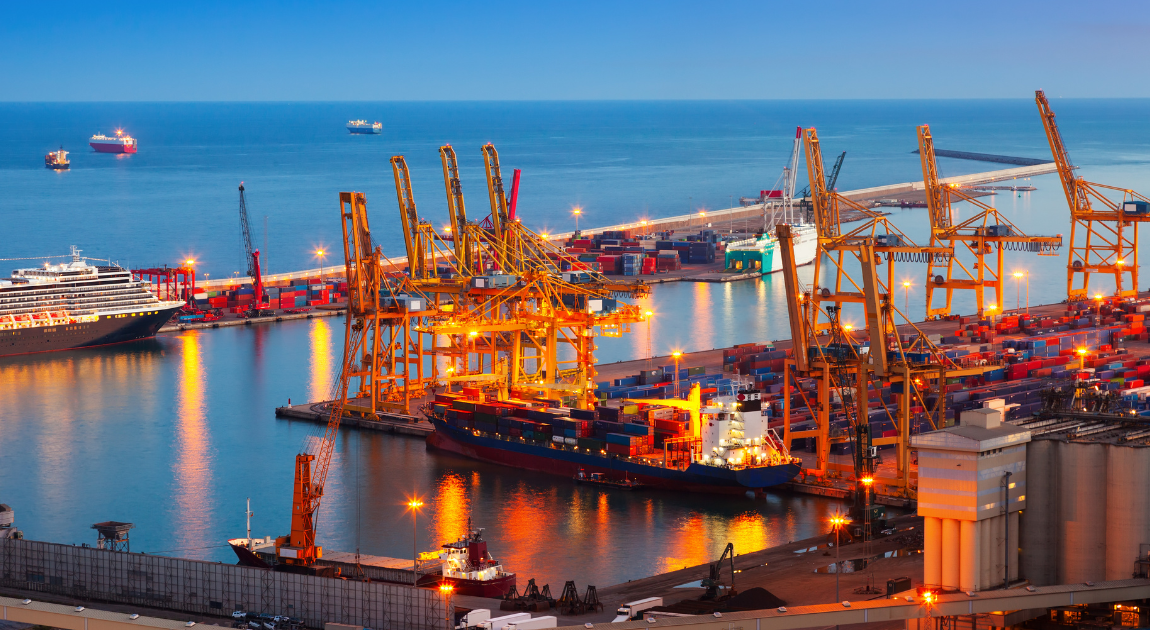Ocean freight management software is a growing niche in the market – and it has its own specifics. No two seas are completely alike, and neither are any two business models that involve maritime trade, so it’s a good idea to select the software that will accommodate yours, whether you are a freight forwarder, a carrier, or a 3PL. Let’s look at what makes sea freight solutions different from other types, and what options businesses of different types and sizes have.
The current ocean freight software market
Ocean freight management software is a blanket term that covers quite diverse digital platforms; what unites them is the purpose – optimizing maritime shipping. The actual aspects in focus include booking, documentation, tracking, route planning, and cost estimation. It’s a large sector, too: the global ocean freight software market is projected to reach $3.6 billion by 2032, from $1.8 bln in 2023.
A lot changes in sea freight, as well – meaning the most successful software products in the industry need to be helpful in adapting to route-altering geopolitics, ship diversions, rising container rates, and the like. This is where a lot of market players are looking hopefully at AI and blockchain to enable real-time tracking, automation, and decision making.
Another driving factor is environmental regulations and the push for sustainability, which also impacts what the sea freight solutions look like – notably in optimizing fuel consumption and monitoring emissions. All in all, the market is definitely poised to diversify a lot in the coming years. But what is it that warrants a specialized ocean freight system? How does it differ from, say air freight or overarching software?
What makes sea freight management systems different?
Maritime shipping largely differs from air, road, or rail freight in scale, complexity, and some of the regulatory aspects. Scale is a large factor here – after all, over 80% of traded goods by volume (and 70% by value) are transported via sea. These are thousands upon thousands of large, bulky containers that take up space and other resources in port logistics, while requiring compliance.
And they still are expected to arrive in time. Unlike air freight, where transit times are measured in days, ocean shipments can take 2-6 weeks, depending on route and transshipments. As a result, ocean freight software places greater emphasis on ETA forecasting, real-time vessel tracking, and container status monitoring. For example, the average container ship calls at over 30 ports per year, requiring tools that integrate port schedules, terminal APIs, and customs clearance systems.
Ocean shipping is also subject to volatile pricing. The Drewry World Container Index reported that container rates on key routes (e.g., Asia–Europe) fluctuated by over 300% between 2020 and 2022, and spiked again by 40–50% in early 2024 due to the infamous Red Sea disruptions. To help manage it, ocean freight software often includes rate management modules and contract negotiation tools to help shippers navigate these swings.
Finally, compliance is more demanding. Ocean software must account for IMO emissions standards, hazardous cargo rules, and multinational customs protocols, whereas air and road solutions typically support simpler regulatory frameworks.
The benefits of specialized ocean freight systems
Just by looking at the specific demands of sea freight, it’s not hard to deduce that the largest benefit of specialized ocean freight management systems is exactly that they are specialized and take into account the fine points. However, the precise advantages can vary depending on what sort of company is using them – a logistics provider, a shipper, a freight forwarding company, or someone else in the supply chain.
Here are some of the most commonly cited ones:
- End-to-end visibility (important for everyone). Ocean freight systems offer real-time tracking of containers, vessel schedules, port status, and ETAs. This reduces the risk of delays, demurrage charges, and lost containers—issues especially common with transit times exceeding 30–45 days on global routes.
- Streamlined operations (especially valuable for freight forwarders and 3PLs) – features like multi-carrier booking, automated documentation like bills of lading or customs forms, and the like allow to save up a lot of time while the cargo is underway or in a port FTZ.
- Flexibility in rate and contract management (prized by shippers and beneficial cargo owners). Ocean freight pricing is volatile, which is especially noticeable if you’re dealing with large volumes, where even small changes in TEU costs—often ranging from $1,200 to $8,000+ depending on the route—can significantly impact margins.
- Better capacity planning (for carriers).
- Emissions monitoring and easier compliance.
Additionally, specialized systems often integrate with ERP, TMS, and port community systems, creating a seamless data flow and reducing manual entry and error.
Top ocean freight management software as of 2025
Let’s now look at some of the most widely adopted ocean freight management solutions and analyze what features and other factors make them popular.
CargoWise by WiseTech Global
CargoWise is estimated to be used by 13 out of the top 25 global freight forwarders – which is already a giveaway sign this is a system for larger companies: global logistics operators, large forwarders, multinational 3PLs and the like. It is a very robust solution, with fully integrated capacities for freight forwarding, customs compliance, warehousing, transportation, and cross-border compliance engine (supporting over 160 countries).
In brief, the more complex operations get, the more likely a company is to go for CargoWise. Additional features include direct carrier connectivity and document automation tools, as well as container tracking.
Freightos WebCargo
Freightos WebCargo specializes in real-time freight rate management and instant online bookings, thus becoming a favorite for freight forwarders and carriers that juggle tons of quotes at any given moment. It connects forwarders directly to over 67 carriers, enabling instant quoting, booking, and eAWB/eBOL generation—saving time and improving pricing transparency.
What sets Freightos apart is its marketplace model and carrier-direct API connectivity, making it one of the few platforms that allows live rate comparisons across multiple ocean and air carriers. This is especially beneficial for forwarders seeking agility in a volatile freight market. The platform processes over 1 million digital freight transactions annually, and its analytics dashboard helps businesses monitor pricing trends and win rates in real time.
Magaya Supply Chain
Placed comfortably in the “Goldilocks zone” of the ocean freight solutions spectrum, Magaya is an end-to-end logistics suite with freight forwarding, WMS, CRM, and accounting all built in, plus a good potential for customization.
It is this all-in-one plus customization approach that earns Magaya a place among mid-sized freight forwarders and 3PLs who want a single source of truth they can then build upon (and with an intuitive UI that doesn’t require months of training). As an additional boon, there’s robust support for compliance documentation, quote generation, and customer service tools. For eCommerce-oriented companies, it integrates with QuickBooks and Shopify, too.
Freightify
Freightify is largely intended for the modern generation of small-to-mid-size freight forwarders that are focused on digital quoting and client experience – in the form of digital sales portals. It excels in rate management, allowing users to upload, compare, and share ocean and air freight rates seamlessly, and offers real-time vessel tracking and sailing schedules.
The standout feature of Freightify is its white-labeled customer portal, which allows forwarders to give their clients a branded digital experience for quoting, tracking, and booking. Unlike bulkier systems, Freightify focuses specifically on improving sales velocity and visibility for small-to-mid-sized logistics companies.
Pazago
In the league of entry-level ocean freight solutions, Pazago is one of the best matches. It’s a lightweight, cloud-based platform that emphasizes simplicity and accessibility. The target users are SMEs and exporters that need the affordable essentials – container tracking, document generation, and shipment scheduling.
Apart from low entry barrier, its competitive edge is also in its regional focus, especially for markets in Asia, Africa, and South America. Pazago integrates with local freight carriers and port authorities and provides a mobile-first interface for users with limited access to traditional desktop tools. While it doesn’t offer the breadth of features seen in platforms like CargoWise, Pazago’s user-friendly design and multilingual support make it a strong option for businesses starting to digitize their freight processes.
Where to look when choosing sea freight software
There are several factors that define the choice of ocean freight management system regardless of what kind of business you are – but the main ones actually look different depending on your place in the supply chain, size, and region. The universal considerations include:
- Scalability – Can the system grow with your operations?
- Integration capabilities – Does it sync with your TMS, WMS, or ERP?
- Support & compliance – Is it updated for regulations like IMO 2023?
- User experience – Is it easy to use for your team and partners?
These ones are essentially a checklist that’s good to use after you’ve defined the solution format you want, and the features list. But the features you may need will ultimately correlate with your business processes.
- For freight forwarders and 3PLs, especially those handling multiple carriers and routes, look for systems with multi-modal support, rate management, carrier integration, and automated documentation (e.g., bills of lading, customs clearance).
- If your priority is providing a better digital experience to your customers, ensure the platform offers white-labeled portals, live tracking, and CRM integrations.
- Shippers and BCOs (Beneficial Cargo Owners)—particularly manufacturers or retailers shipping large volumes – most frequently prioritize systems with contract rate visibility, cost forecasting, and supply chain visibility across multiple shipments. Look for tools that integrate with your ERP and offer analytics dashboards to monitor shipping spend and delays.
- Smaller businesses or exporters in emerging markets typically look for affordable, easy-to-deploy solutions like Pazago. Key features include basic shipment tracking, digital documentation, and mobile access.
When is it sensible to aim for custom solutions?
Finally, there is always the option of going fully custom, so that your company’s system will completely match your workflows and know-hows. Naturally, most of those who ultimately settle for custom solutions are large carriers, multinational 3PLs, or shippers with extremely complex supply chains, but in some cases, SMEs are also in the club.
For example, in some cases the system used will require tight integration with specific systems like proprietary ERPs, particular port infrastructures, or legacy software. Some businesses manage niche commodities with quite exotic compliance needs, while some will make client-facing features part of their modus operandi (and competitive edge). All of this might warrant a custom solution.
In most cases, though, custom ocean freight software development is about integrations and “fill-in-the-gaps” modules or tools – which is, in many cases, a more feasible option than reworking the operations to match what one single particular platform allows for.
Whether you’re a growing logistics provider or a high-volume shipper, there’s a solution built for you. Start by mapping your needs, evaluating feature sets, and exploring demos of top systems. If you’re unsure where to begin—or wondering whether custom development is the answer—we’re here to help guide your digital logistics journey.














